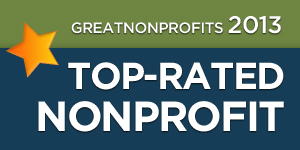With open eyes, beautiful moments are easy to find in Rwanda. That’s often a surprise to first-time visitors. Stories and images of the 1994 genocide from news reels and memoirs are many people’s only reference points. So, we’ve been moved by the distinctly different email updates that we’re receiving from Mothering Across Continents-supported volunteers who are in Rwanda right now. Beautiful flowers, a high school girl sitting under 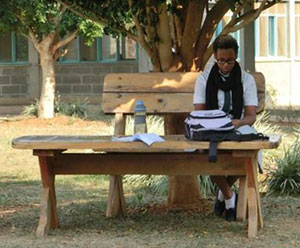 a tree reading, a stroll up a cobblestone pathway. All are reminders that nature’s artistry, opportunities to quietly reflect, and a sense of connection are available around the world. So are examples of aspiration and leadership. A visit to Gashora Girls Academy, not far from the capital of Kigali, inspired US Physics teacher Deb Semmler’s breathless end-of-day reflection: “WOW! . . . Gashora is 3.2 miles down a dirt road on the edge of a beautiful lake. The
a tree reading, a stroll up a cobblestone pathway. All are reminders that nature’s artistry, opportunities to quietly reflect, and a sense of connection are available around the world. So are examples of aspiration and leadership. A visit to Gashora Girls Academy, not far from the capital of Kigali, inspired US Physics teacher Deb Semmler’s breathless end-of-day reflection: “WOW! . . . Gashora is 3.2 miles down a dirt road on the edge of a beautiful lake. The  students run the school. They make decisions on how the school operates, and they have pride. The three girls that we talked and walked around the school with have big dreams and are high achievers . . . We talked about the summer leadership program they are part of. This summer, 123 girls from around the world (50 from the US and Canada) are spending three weeks learning about leadership and girl power.” As Deb has commented more than once on her experience in Rwanda, “A great day in Africa.”
students run the school. They make decisions on how the school operates, and they have pride. The three girls that we talked and walked around the school with have big dreams and are high achievers . . . We talked about the summer leadership program they are part of. This summer, 123 girls from around the world (50 from the US and Canada) are spending three weeks learning about leadership and girl power.” As Deb has commented more than once on her experience in Rwanda, “A great day in Africa.”
Tag Archives: students
Science Education for Girls in Rwanda
It’s been awhile since we posted a blog on our website. Physics teacher Deb Semmler’s trip to Rwanda makes it worth starting up again. Through Mothering Across Continents, she is guest teaching and providing professional development training for physics, chemistry and biology teachers for nearly three weeks. It’s her first trip to Africa.
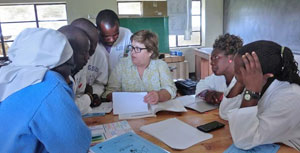 I’m at an all-girls high school that we call “Biyimana” for short. The school, managed by nuns, was founded in 1955 with the first class graduation in 1959. The school is very well-established and they raise cows to provide fresh milk for the students, as well as chickens for eggs, pigs, and rabbits to sell to provide beef for students. They have large gardens that provide fruits and vegetables for the students, including carrots, beets, and bananas. They seem fully self-supporting and have men who tend to the livestock and gardens. Nobody wants for food here, and there is no food desert as far as I can tell. I see fresh fruit and vegetable at every meal and available along the “road” as we drive to and from the school. I drank warm fresh milk for the first time ever at lunch (so far, so good, not sick).
I’m at an all-girls high school that we call “Biyimana” for short. The school, managed by nuns, was founded in 1955 with the first class graduation in 1959. The school is very well-established and they raise cows to provide fresh milk for the students, as well as chickens for eggs, pigs, and rabbits to sell to provide beef for students. They have large gardens that provide fruits and vegetables for the students, including carrots, beets, and bananas. They seem fully self-supporting and have men who tend to the livestock and gardens. Nobody wants for food here, and there is no food desert as far as I can tell. I see fresh fruit and vegetable at every meal and available along the “road” as we drive to and from the school. I drank warm fresh milk for the first time ever at lunch (so far, so good, not sick).
The teachers use questioning and have students individually go to the board, do the work, and explain each step of a problem or question to the others. They use science note booking for taking notes and doing problems (two separate books). The students’ notebook are impeccable, using ink and rulers to draw. They don’t make mistakes and have perfect handwriting.
One morning, I did professional development training with 2 biology teachers, 2 chemistry teachers and one physics teacher. We started with the hydrophilic bead that I had left in water overnight . . . with the coin that is invisible when there is no excess water and visible with excess water due to light refraction in the air space.
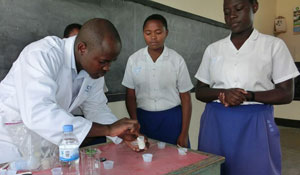 I made a short presentation using the projector on the newest research on how people learn, not by reading and rereading but by testing themselves overtime. That led me to show them how we use “foldables” so students can take notes and test their knowledge over time. The teachers separated into subject groups and made their own. One bio teacher one a foldable of fungi. The other made one on the difference between DNA and RNA. The chemistry teachers made one on acids and bases. I worked with the physics teacher on some of the physics specific material (FCI and graphing diagnostic) and computer documents that I am sharing. I showed the chemistry teacher the acid/base pH PhEt interactive lab that shows the same thing as doing an actual lab. We did a pH lab with the NaOH and pH paper I brought and transmission of disease lab.
I made a short presentation using the projector on the newest research on how people learn, not by reading and rereading but by testing themselves overtime. That led me to show them how we use “foldables” so students can take notes and test their knowledge over time. The teachers separated into subject groups and made their own. One bio teacher one a foldable of fungi. The other made one on the difference between DNA and RNA. The chemistry teachers made one on acids and bases. I worked with the physics teacher on some of the physics specific material (FCI and graphing diagnostic) and computer documents that I am sharing. I showed the chemistry teacher the acid/base pH PhEt interactive lab that shows the same thing as doing an actual lab. We did a pH lab with the NaOH and pH paper I brought and transmission of disease lab.
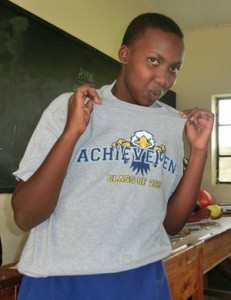 The chemistry teacher asked if I could make the electrolytic cell lab he had in his notes, using a battery and two conducting probes. We made it work with the conductivity tester I brought, and he used it in his classroom along with the pH paper test with salt (NaCl), pure water and a strong base (NaOH). The students did the tests and shared results. These are excellent teachers. They just need resources! Sometimes language is a barrier, so it’s been suggested that students write notes to our students at East Mecklenburg High, and our students write back. I also asked how we could bring 6 to 10 visiting teachers and students here, and transfer them from the hotel to the school along the rough road. transfer many. The answer is to rent a state operated bus and driver.
The chemistry teacher asked if I could make the electrolytic cell lab he had in his notes, using a battery and two conducting probes. We made it work with the conductivity tester I brought, and he used it in his classroom along with the pH paper test with salt (NaCl), pure water and a strong base (NaOH). The students did the tests and shared results. These are excellent teachers. They just need resources! Sometimes language is a barrier, so it’s been suggested that students write notes to our students at East Mecklenburg High, and our students write back. I also asked how we could bring 6 to 10 visiting teachers and students here, and transfer them from the hotel to the school along the rough road. transfer many. The answer is to rent a state operated bus and driver.
This is why I am here! These teachers, like most I know, love their students and work very hard to help them be successful. The headmistress watched the whole physics class and was very happy to see the students engaged.
Top Ten List of Reasons our Eyes were Opened, Heads were Left Buzzing, and Spines are Still Tingling
Saturday, April 5, was a big day for us. In January, we officially took the plunge to plan and deliver the Any1Can You’re It! Global Youth Service Summit. It constituted a series of firsts . . . first time we hosted a youth service summit, first time we served as Youth Service America’s local lead agency, first time students from public and private high schools across the Charlotte-Mecklenburg School District came together in conjunction with Global Youth Service Day (April 11). We knew it would be a day of surprises – as are all “events.” But we really underestimated how much we would learn in the presence of approximately 125 students who are service leaders at 16 different schools. Given that the event came on the heels of “Top Ten Reasons” originator David Letterman announcing he will retire, we’re offering our “Top Ten List of Reasons our Eyes were Opened, Heads were Left Buzzing, and Spines are Still Tingling.” In reverse order, of course:
10. STUDENTS WILL GO OUT OF THEIR WAY ON A SATURDAY.
When we first decided to move ahead with the event, with limited time to  organize sponsors, partners, and commitments to attend, we held our breath. Will students come to a summit on a Saturday? We learned that we underestimated how moved and motivated they would be by the opportunity to come together to learn about and share experiences with service projects.
organize sponsors, partners, and commitments to attend, we held our breath. Will students come to a summit on a Saturday? We learned that we underestimated how moved and motivated they would be by the opportunity to come together to learn about and share experiences with service projects.
9. MUSIC MATTERS.
One of our facilitating partners, Leading2Change, insisted that we couldn’t have a youth summit without the right music. They were right. It was one of those intangibles that said “This summit is for you.”
8. SPECIAL VISITORS TAKE PEOPLE’S BREATH AWAY.
Our keynote speaker was 18-year-old Charles Orgbon, founder of Atlanta-based Greening Forward. He started his non-profit environmental efforts in the 6th grade. He’s now a high school senior. In six years his organization has supported projects engaging 2,000 students and 10,000 adults in environmental service.
7. LOCALS INSPIRE TOO. 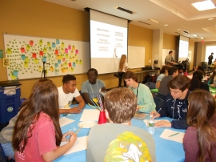
Students and an adviser from Charlotte Latin attended. We learned that this year they’ve raised $35,000 to support a school project in Tanzania, and they’re still going! Two students were the catalysts who proposed the project.
6. See #8 and note…
WE UNDERESTIMATE YOUTH, AND THEY UNDERESTIMATE EACH OTHER.
A common refrain was, “I had no idea other schools are working on stuff like we are at our school. I thought we were the only ones who cared about global issues and service.”
5. BETTER FUEL UP.
If you want a successful event, surprise students with fresh, hot pizza and snacks they like. Thanks, Fuel Pizza. Thanks, LANCE for the chips. Thanks, EarthFare for the apples, bananas and yummy juice. A collective gasp arose and hands clapped when we shared that lunch included you.
4. MISSING SKILL – ADVOCACY.
Asked for examples of their activities in the realms of Awareness, Service, Philanthropy or Advocacy, there were plenty of examples of the first three – almost no examples of the last (Advocacy). Facilitators asked “Why?” Participants responded: “Who wants to hear from
us?” and “We don’t know how to advocate.”
3. IF YOU WANT HONESTY, EXPECT UNCOMFORTABLE MOMENTS.
Like…the student troupe that performed at lunch and named specific issues at specific schools. Like…the dialogue in the economy workshop led a participant to share that his father lives and works in New York, while the family lives in Charlotte, because that’s where his father found the best job to put food on the table. They SKYPE each night, but miss each other a lot.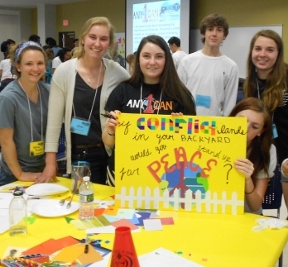
2. PEACE WINS.
Given seven different themes as options for creating a service campaign (education, poverty, hunger, water, peace, tolerance, and environment), peace and its parallel tolerance win out. But the truth is, we as facilitators don’t know why. We simply noticed a pattern.
1. FIRSTS ALWAYS LEAD TO THE QUESTION – WHAT NEXT?
Some students exchanged contact information on the spot and declared, “Look at me – I’m networking.” Twitter, Facebook and Instagram received their fair share of traffic. And the
general sentiment from students and facilitators indicated, this was a great first step.
And so . . . ?!
What are teachers doing to prepare students for the world of tomorrow?
Adults with children attending school in countries with developed economies are hearing a common theme these days . . . “We need to focus on developing global citizens with 21st century skills.” But interview teachers (which we often do as creators of The Global Class and Any1Can Project), and you hear the practical challenges at hand. There are high expectations of (and pressure on) today’s educators to effectively teach to established curricula and help students improve scores on standardized exams. So, how and where can they integrate global education in ways that align with what they’re already teaching and are presented in new, innovative and engaging ways that appeal to students – especially teenagers in high schools?
As one contribution to the answer, we offer up Exhibit A – the 9th grade English teachers and administrators of Myers Park High School in Charlotte, North Carolina, USA. This year, with the support and encouragement of a new principal, Mark Bosco, interested in expanded global knowledge and problem-solving skills, these teachers launched a year-long program that culminates in April.
Step 1: They participated in professional development on how to incorporate seven global issues into the classroom.
Step 2: They introduced the history and context of South Sudan and the f ormer Lost Boys of Sudan into their classrooms through articles, videos, an assembly, and dialogues.
ormer Lost Boys of Sudan into their classrooms through articles, videos, an assembly, and dialogues.
Step 3: They connected classroom learning to efforts of a student club that took the lead on sharing with the rest of the school what was going on in 9th grade English.
Step 4: Working in an integrated way, the 9th grade English teachers and student club members planned a 3-mile “Walk for Wisdom” to raise funds for adult literacy in South Sudan. The walk takes place on Friday, April 4, with nearly 700 of the high school’s 3,000 students registered.
Step 5: After the walk, in April, the teachers are leading classroom reflection conversations a bout the relationship between what students learned about South Sudan and themes of education, conflict and intolerance in classic literature, specifically Romeo and Juliet and The Odyssey.
bout the relationship between what students learned about South Sudan and themes of education, conflict and intolerance in classic literature, specifically Romeo and Juliet and The Odyssey.
Step 6: All of the 900 English students in 9th grade are learning to use online technology to create “memes” that juxtapose images from South Sudan with famous lines from “R&J” and “Odyssey.”
And there’s a culmination. By May, these memes will be curated for presentation at the school and in public.
Next time you hear someone say, “What are teachers doing to prepare students for the world of tomorrow?” feel free to think about this moment in time that links a photo of a few teachers sitting in a circle of student desks and what emerged from it. 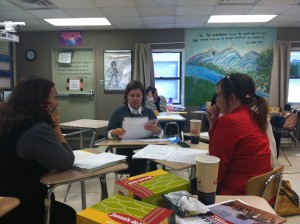
Testimonials say it all!
We greatly appreciate the testimonials and reviews we have received from a variety of people we have worked with. Here are a few examples…
“Mothering Across Continents assisted our school in becoming a part of a global service project and helped our faculty understand the complex problems that surround need in developing countries. We wanted to focus our service project around the idea of clean water and discovered their global classroom materials online. They came to us to deliver staff development, as well as, student leadership development. Students grew in their knowledge of global problems and became partners to affect change in South Sudan. They have gained a better understanding of issues like poverty, conflict, hunger, and resource management. Most importantly our school understands that we have a place in the global community and our responsibility is to educate students, our own community and to reach out and partner with those who need help.”
~ Amy (Teacher)
“I had the opportunity to work with Mothering Across Continents on a project my senior year of high school. Not only were we successful in our project, they were very helpful at letting the students learn the ins and outs of the business. We were treated like peers and adults but at the same time if we needed help with anything they were always there. The people from MAC that we worked with were incredibly personable and I still keep in touch with one which I think really shows that they care about more than just raising the money but the people they are working with as well. I still continue to donate money to the causes they have and I hope to even work with them in the near future as an intern or still as a volunteer!”
~ Shelby (Student)
“A Lost Boy of Sudan, James Lubo Mijak, and I had a dream to build a school in South Sudan back in 2009. We were floundering until we met Mothering Across Continents. Since then, with their tireless direction and support, we’ve raised more than $300,000 and have completed a school in one of the most remote places in the world. We simply could not have done it without them. And, there is so much more work to do and MAC is committed to seeing it through with us.”
~ Phillips (Project Catalyst)
“Mothering Across Continents has created a solid framework by which our team is in the process of creating two sustainable school projects in South Sudan. Even though working in South Sudan is extremely difficult, our project, designed by Mothering Across Continents has met goals that other groups have only hoped to achieve.”
~ Karen (Project Catalyst)
To read more, or add your own, visit our page on Great Non-Profits where we received one of the first Top-Rated Awards of 2013. 